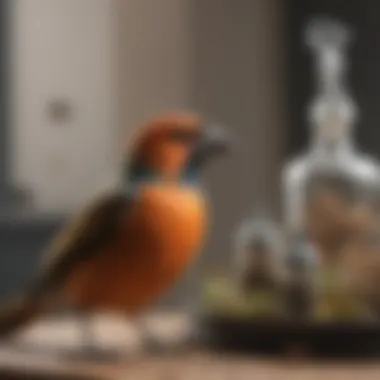Smells That Deter Birds: Effective Strategies Unveiled


Intro
Birds can be charming elements of nature, enriching our gardens and backyards with their songs and movements. However, they can also become nuisances, particularly for homeowners and gardeners. Understanding how to effectively deter these avian visitors can safeguard valuable plants and lessen disturbances. One intriguing approach involves the scents that affect bird behavior. By leveraging specific odors, we can create environments that are less appealing to various bird species. This article delves into the scientific foundation of bird olfaction, identifies scents that serve as repellents, and discusses practical applications for those seeking solutions without harming these creatures.
Moreover, this exploration will go beyond just identifying odors. It will consider the ethical implications and environmental impacts of using such methods. Traditional bird deterrents often rely on physical barriers or harmful chemicals. In contrast, utilizing smells presents a potentially safer and more humane option for managing avian populations.
Let’s move forward to examine how these methods can be practically applied.
Understanding Bird Olfaction
Understanding bird olfaction is crucial for developing effective methods to deter birds. Birds have often been assumed to rely primarily on their vision, but recent research demonstrates that smell plays a significant role in their behavior. This understanding opens new avenues for non-invasive and environmentally friendly bird control methods. By leveraging unique odors that birds find unpleasant, we might mitigate unwanted avian interactions in gardens, farms, and urban settings.
The Science of Smell in Birds
Birds possess a sophisticated olfactory system that enables them to detect and distinguish a wide array of scents. Contrary to outdated beliefs, birds have olfactory receptors that are not only functional but also finely tuned to various odors in their environment. Research indicates that the olfactory bulb in birds, which processes scent information, can be surprisingly large relative to their brain size. Different species exhibit varying degrees of reliance on olfaction, with some known to use smell for navigation, foraging, and even mate selection. This depth of understanding can help us choose appropriate scents that are aversive to specific bird species.
How Olfactory Cues Influence Behavior
Olfactory cues can profoundly influence bird behavior in numerous ways. Many birds use olfaction to locate food sources, as certain smells can signal the presence of ripe fruits or seeds. Additionally, some species rely on specific scents to detect predators or find safe nesting grounds. Birds have also been observed responding to the scents associated with danger, leading them to modify their behavior in those environments.
Understanding these responses can help us craft targeted deterrents that not only repel birds effectively but also ensure that those methods remain non-harmful to the birds themselves. For instance, using strong scents like vinegar or peppermint strategically can be a natural deterrent without causing distress to the bird population.
"Birds are not just visual creatures; their sense of smell plays a critical role in their survival and behavior."
By understanding olfaction in birds, we can design practical approaches that are both humane and effective. This knowledge informs various methodologies that make use of scents to control bird populations in a way that promotes coexistence rather than conflict.
Common Smells That Deter Birds
The significance of common smells in deterring birds cannot be overlooked. Various scents have the potential to influence bird behavior and are utilized in multiple contexts, from protecting gardens to managing outdoor spaces. Understanding which odors can effectively repel birds lends itself to more environmentally friendly pest management strategies. These methods present fewer risks to biodiversity compared to traditional chemical repellents, making them attractive options for homeowners and gardeners alike.
Citrus Scents
Citrus scents, including lemon, orange, and grapefruit, are commonly reported as effective deterrents for certain bird species. Birds, particularly those that rely on visual cues more than olfactory ones, often find these strong fragrances unpleasant. The sharpness of citrus odors tends to disrupt their sense of smell.
Researchers have noted that some birds, such as pigeons and sparrows, react negatively to citrus products like citrus essential oils or peels. When applied near bird-attracting areas, these scents can significantly reduce bird activity. Homeowners can use citrus-scented sprays or plant citrus trees to create a natural barrier against unwanted birds.
Peppermint and Other Mints
Peppermint, along with other mint variants such as spearmint, also plays a crucial role in deterring birds. The strong, sharp odor of mint can often be perceived as a threat by various bird species. Birds may associate these smells with natural predators or noxious substances.
To utilize peppermint effectively, homeowners can mix peppermint oil with water to create a spray, or simply place mint leaves around the garden. Notably, mint plants can thrive in garden beds, offering aesthetic benefits while simultaneously keeping pesky birds away.
Vinegar and Its Efficacy
Vinegar is another scent that has shown to deter birds successfully. When used as a spray, the sharp, acerbic odor of vinegar can create an unwelcoming environment for birds. This scent interferes subtly with their natural behavior, encouraging them to seek food elsewhere.
To apply vinegar effectively, it can be mixed with water and utilized as a spray on areas where birds tend to congregate. It's important to note that while vinegar may not be effective against all bird species, it can still provide some level of deterrence. Furthermore, vinegar is non-toxic and eco-friendly, making it a suitable option for conscientious gardeners.
Spices: A Natural Deterrent
Spices like cayenne pepper, cinnamon, and garlic have been noted for their bird-repelling properties. The strong flavors of these spices can create a hostile environment for birds, as the scents may signal danger or discomfort. Spices can be applied in various forms: sprinkled around the garden or mixed with water to create a potent spray.
Many gardeners take advantage of spices not only for their protective qualities but also for their natural origin. They represent a sustainable approach to bird control, often being more effective than synthetic alternatives. Using these natural deterrents encourages a healthier ecosystem by minimizing chemical use.


"Utilizing scents like citrus, peppermint, vinegar, and spices provides homeowners with various options for natural bird deterrence while being mindful of the environment."
In summary, understanding and harnessing these common smells can empower individuals to manage bird populations more effectively without resorting to harmful chemicals. The practical approaches outlined here pave the way for a bird-friendly yet controlled outdoor environment.
Bird Species and Their Reactions to Smells
Understanding how different bird species react to various smells is crucial in creating effective deterrent strategies. Each species possesses unique olfactory capabilities, influenced by their evolutionary history and habitat preferences. This diversity means that a scent that repels one species might be neutral or even attractive to another. Therefore, identifying the specific reactions of bird species to certain smells is key in the practical application of scent-based repellents.
Birds have a less developed sense of smell compared to mammals, but recent studies have shown that some species use olfactory cues for foraging and navigation. For example, seabirds often rely on odor to locate food over vast ocean distances. This highlights that the role of smells in a bird's behavior cannot be underestimated, especially when seeking to influence their movements.
A comprehensive understanding of species-specific responses assists homeowners and gardeners in targetting their deterrence efforts. By tailoring scents to the specific birds that frequent their areas, they can enhance the efficacy of their bird control methods, thus protecting their gardens and property from unwanted visitors.
Species-Specific Responses
Every bird species reacts differently to specific smells due to their unique evolutionary adaptations. This section delves into how various birds detect and process odors, ultimately guiding their behavioral responses. For instance, a study on European starlings indicates that they are significantly deterred by the scent of citrus, while sparrows may exhibit indifference.
The effectiveness of various scents can vary based on the ecological niches these birds occupy. Species that forage on fruit may be more sensitive to sweet and fruity scents, while insectivorous birds might respond differently to floral scents or even spices. These differences mean that identifying the species present in an area is essential for effective deterrence.
Some species are found to have an impressive ability to recognize and remember certain smells. For example:
- Common Grackles associate specific scents with danger after a negative experience.
- Pigeons utilize smell for route navigation, thus certain odors can mislead them.
Understanding Species Preferences
To effectively deter birds, it is important to consider their individual preferences for specific scents. The research indicates that birds may have distinct scent preferences influenced by their diet, habitat, and breeding behaviors.
Birds with a diet primarily consisting of plants, such as parakeets, may show a notable aversion to sharp or pungent smells, which could be linked to their natural avoidance of toxic or unripe fruits.
Conversely, predatory birds might be more receptive to scents associated with prey. Understanding these tendencies allows for the development of more focused approaches in using smell as a deterrent.
Identifying the scents that resonate—or repel—different bird species provides invaluable insight for managing avian interactions in various environments.
In summary, it is vital to research and understand both species-specific responses and preferences. This knowledge not only enhances the effectiveness of smell-based bird deterrents but also promotes a harmonious relationship between humans and wildlife.
Practical Application of Scents in Bird Deterrence
The practical application of scents in bird deterrence is significant because it provides homeowners and gardeners with ecological alternatives to traditional control methods. Utilizing smells to deter birds capitalizes on their olfactory senses, allowing for a non-lethal approach to managing bird populations. With increasing concern for wildlife conservation, the ability to repel birds using natural or synthetic scents is both humane and effective. This method can reduce the negative impact on bird species while also protecting gardens and properties from unwanted birds.
Methods of Application
Using Essential Oils
Using essential oils offers a direct way to implement scent-based bird deterrents. Essential oils such as peppermint, eucalyptus, and citrus have unmistakable aromas that many birds find aversive. The key characteristic of essential oils is their concentrated nature, providing long-lasting fragrance with minimal application. They are a popular choice due to their effectiveness and eco-friendly profile, which aligns with conservation efforts.
A unique feature of essential oils is their versatility; they can be used in various forms such as diffusers, sprays, or even soaked on cloths placed around gardens. However, it's important to note that while many of these oils are safe for humans and pets, they may affect some sensitive bird species differently. In general, the advantages of using essential oils include ease of application and their potent deterrent effects.
Creating Scented Sprays
Creating scented sprays is another efficient method for utilizing smells in bird deterrence. A mixture of water and specific odorants, such as vinegar or essential oils, can easily be made at home. The key characteristic here is that scented sprays are user-friendly; they can be applied widely and in targeted areas where bird activity is high.
The unique feature of creating scented sprays lies in the adjustable concentration of the scents used. This can range from subtle to intense, depending on individual preferences and specific scenarios. Though effective, some may find that scented sprays require frequent reapplication, especially after rain or heavy gardening activities. Overall, the benefits include a low-cost solution adaptable to different environments.
Planting Aromatic Species


Planting aromatic species is an innovative approach, integrating biodiversity with deterrent strategy. This entails adding herbs or flowers with strong scents, like rosemary or lavender, to a garden. The key characteristic of this method is its dual function; these plants not only deter birds but also enhance the garden aesthetically.
A unique advantage of planting aromatic species is their sustainability—once established, they can provide ongoing deterrence without the need for continuous application. However, this method may require careful selection of plants that thrive in specific environments and conditions. While effective, the potential downside is the time taken for plants to mature and reach an optimal level of scent production.
Location and Timing Considerations
When applying scent-based deterrents, paying attention to location and timing is crucial. Location factors include where birds are most likely to congregate, such as near food sources or nests. This ensures that the scents are more likely to deter birds effectively. Timing considerations are equally important, as specific seasons may see increased bird activity, impacting the effectiveness of scent applications. Being mindful of these factors can significantly enhance the overall success of implementing scent strategies for bird control.
Evaluating the Effectiveness of Smell Deterrents
Evaluating the effectiveness of smell deterrents is a crucial aspect of this exploration. Understanding how well certain scents work can help homeowners and gardeners determine the best strategies to keep unwanted birds at bay. Knowledge of these deterrents leads to better decision-making, ensuring that efforts are not wasted on methods with limited success.
Comparative Studies and Research
In the realm of using odors to deter birds, looking at comparative studies and research is vital. Insights from scientifically backed studies provide a clearer picture of how different scents perform. They reveal varying effectiveness based on the specific species of birds and the context in which the scents are applied.
How Different Scents Perform
When we consider how different scents perform, we understand that not all smells have the same repellent effect. For instance, citrus scents may repel some species like pigeons while being ignored by others. This variance comes from each species' specific olfactory receptors, which react differently to certain scents.
- Key Characteristic: Each scent interacts uniquely with a bird's sensory system, influencing its behavior.
- Benefit: Knowing which scents are effective for particular species can enhance targeted approaches towards bird control efforts.
- Unique Feature: The adaptability of scent combinations can enhance efficacy, allowing for a customized deterrent strategy.
The primary advantage in this area is that homeowners can make more informed decisions. They can select scents that have proven results for their specific bird-related issues. However, a potential disadvantage lies in the need for continuous research, as effectiveness can alter over time due to environmental changes.
Long-Term Observations
Long-term observations play an essential role in understanding scent-based bird deterrents. These studies look beyond immediate reactions to assess how bird populations respond over extended periods.
- Key Characteristic: Long-term observations can identify sustained patterns in bird behavior.
- Benefit: This information helps in setting realistic expectations about how long deterrents remain effective.
- Unique Feature: It allows researchers to monitor any shifts in species behavior that may require adjustments in deterrent strategies.
From a practical standpoint, long-term data can be incredibly valuable for devising ongoing management plans. Homeowners benefit from understanding how these scents work over time and whether they need to change tactics as birds adapt. On the other hand, the major disadvantage is that long-term studies require more resources, which may not be feasible for all individuals.
Limitations of Scent-Based Methods
While the potential for using scents to deter birds is significant, they come with limitations that must be considered. These methods are not universally applicable. Specific environmental factors can reduce their effectiveness, such as weather conditions or the scent's dispersion in the open air. Moreover, certain birds may acclimatize to repeated exposure, leading to decreased efficacy over time.
- Considerations: Homeowners should think about the irregular success rates of different methods and adjust their expectations accordingly.
- Potential Issues: Misapplication of scents without thorough understanding may lead to ineffective deterrence.
In summary, evaluating the effectiveness of smell deterrents requires careful consideration of scientific research and practical observations. This evaluation provides valuable insights for homeowners seeking non-invasive ways to manage bird populations, balancing effectiveness with respect for wildlife.
Ethical Considerations in Bird Deterrence
Understanding the ethical considerations in bird deterrence is crucial for anyone engaging in methods to prevent birds from invading specific spaces. While the primary goal may be to protect gardens or property, it is paramount to ensure that the methods employed do not harm birds or their habitats. This section discusses the importance of ethical practices in bird deterrence, emphasizing the need for humane and environmentally friendly approaches.
Environmental Impact of Methods
When considering various bird deterrent methods, one must assess their environmental impact. Chemical deterrents may pose risks to not only the targeted bird species but also other wildlife and plants in the ecosystem. Non-target species can inadvertently be affected by these chemicals, leading to negative consequences in the local biodiversity.
For instance, certain synthetic scents, while effective in repelling pests, might cause unintended harm. An ecological imbalance could arise if the deterrents eliminate not just birds but also beneficial insects and plants. Therefore, homeowners should prioritize natural deterrents, such as citrus scents or vinegar, which exhibit lower ecological risks.
Here are some minor yet impactful considerations for an environmentally sound approach:
- Research natural alternatives: Utilize naturally occurring scents known to deter birds without environmental damage.
- Limit chemical substances: Avoid overly potent chemical repellents that may have long-lasting detrimental effects.
- Remain aware of local fauna: Tailor the scent strategy based on the specific bird species and their typical surroundings.


"Choosing eco-friendly bird deterrents is not only a responsibility but also a step toward preserving the environment for future generations."
Balancing Control and Conservation
Maintaining the delicate balance between controlling bird populations and promoting conservation requires careful thought. Birds play a vital role in ecosystems, contributing to pollination and seed dispersion. Thus, a solely aggressive approach in repelling birds can lead to conservation challenges.
Homeowners, particularly those with gardens, should aim for methods that deter birds without displacing them from their natural habitats. It is crucial to understand the specific contexts in which bird control is necessary. For example, if a particular bird species is causing damage to crops or fruit trees, identifying that risk while applying humane deterrents can preserve both the landscape and the bird population.
Here are ways to foster this balance:
- Educate yourself on local bird populations: Understand the ecological role of specific birds in the area.
- Integrate deterrents with habitat conservation: Design landscapes that employ deterrents yet allow birds to thrive safely.
- Monitor outcomes: Regularly assess the effectiveness of deterrent methods and adjust strategies as needed.
Encouraging a coexistence between humans and birds can lead to sustainable solutions in bird control. The focus should always lean towards responsible and ethical strategies that respect wildlife while meeting human needs.
Smell Deterrents versus Traditional Methods
The study of bird deterrence has taken on new dimensions with the introduction of scent-based methods. This section aims to clarify the relevance of using odors as a strategy compared to traditional bird control approaches. The underlying premise is the growing need for solutions that are less invasive and more in tune with sustainable practices.
Smell deterrents offer specific advantages over conventional methods. For instance, they can minimize harm to birds and other wildlife. Traditional bird control often relies on physical barriers, shooting, or trapping. These methods can cause stress and potentially harm birds, not to mention the collateral damage to other species. Smell-based deterrents, while not foolproof, may address issues of human-wildlife conflict with greater care.
Additionally, the implementation of scent deterrents is generally straightforward for homeowners and gardeners. Rather than engaging with complex machinery or expensive setups, they can utilize common household items to create effective repelling agents. This accessibility is important for a wide range of users, from casual gardeners to professional landscapers.
Overview of Traditional Bird Control Techniques
Traditional techniques for bird control include several established methods:
- Netting: Often used to cover fruit trees or specific areas, netting can physically block birds but may be unsightly and cumbersome.
- Scarers and Scarecrows: Fear-inducing objects, including plastic owls or reflective tape, aim to create an intimidating environment for birds. While they can work temporarily, birds can become used to them over time.
- Trapping and Culling: These are more severe methods that involve catching and removing birds. This approach raises ethical questions and can impact the local ecosystem.
- Chemical Repellents: Some products claim to repel birds chemically, but safety and efficacy are often debated.
It's essential to note that these methods, while effective to a degree, might not address the root issue of why birds are being drawn to certain areas in the first place.
Comparing Costs and Efficacy
When considering costs, traditional bird control methods may offer immediate solutions but can incur long-term expenses. Physical barriers and scarers often require replacement or maintenance. In contrast, scent-based deterrents can be more economical. Many homeowners can create their own deterrent solutions using readily available materials, thus reducing overall costs.
In terms of efficacy, traditional methods can produce quick, visible results. However, their long-lasting effectiveness is often limited. Birds can develop habituation towards static deterrents. Smell deterrents, on the other hand, may provide variable results, influenced by bird species and environmental conditions. Nevertheless, the ability to adapt and change scents frequently might enhance their effectiveness over time.
"When evaluating bird deterrent methods, understanding the balance between cost, ethical implications, and effectiveness is vital for any approach chosen."
Ultimately, combining scent-based deterrents with traditional methods may offer a more comprehensive strategy for managing bird populations in various settings. Each technique has its strengths and limitations, and understanding these can help inform more ethical and effective bird management practices.
Future Research Directions
The exploration of smells as a deterrent for birds opens various avenues for future research. Understanding the potential of olfactory cues may not only improve current methods of bird management but also enhance wildlife conservation efforts. This section discusses the significance of future research in this area.
Emerging Technologies in Bird Control
Advancements in technology present new possibilities for bird deterrence. Emerging technologies could involve the development of smart scent dispensers that activate based on bird activity. Such devices could utilize motion sensors to assess when birds are present and release specific scents at strategic moments.
Additionally, using drone technology could allow for quick analysis of bird behavior in different environments. By combining data from these observational tools with scent applications, researchers can create tailored deterrent strategies for specific bird species. This would not only improve effectiveness but also significantly reduce the waste of resources.
Potential for Enhanced Scent Formulations
Research into the formulation of scents is crucial for enhancing their efficacy. The ability to blend varying scents or to develop long-lasting formulations could lead to better results in deterring birds. Scientists can experiment with essential oils, plant extracts, and synthetic compounds to find potent combinations that are both effective and non-harmful.
Moreover, it is essential to consider the sustainability of these formulations. Using eco-friendly ingredients aligns with broader conservation goals. Testing these blends on different bird species will lead to more reliable data about their effectiveness. As more is understood about preference and aversion, formulations can be refined further based on empirical evidence.
"The future of bird control lies in marrying the art of scent with scientific rigor to create humane and effective strategies."
The synthesis of knowledge gained from these future directions will help create practical solutions that benefit both humans and birds, ensuring a balanced ecosystem.



